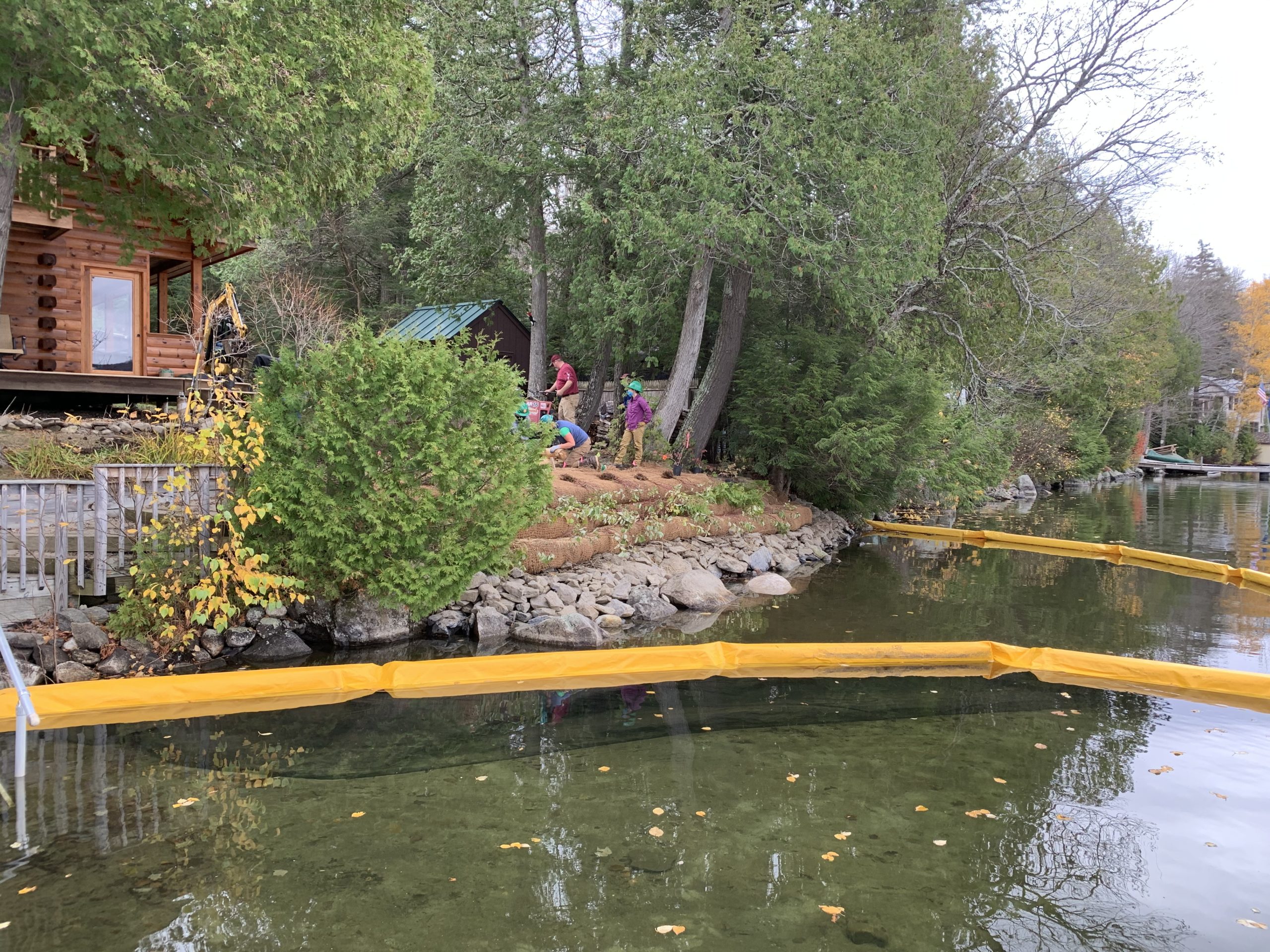

Before & After: The shoreland with a 4-foot-high retaining wall made of deteriorating railroad ties and after coconut fiber rolls and native plants for stabilization were installed.
Maidstone Lake, a treasured waterbody formed 12,000 years ago in the Northeast Kingdom by glacial carving, received a boost in quality from an innovative bioengineering project led by the Essex County Natural Resources Conservation District (NRCD). With funds from the Vermont Department of Environmental Conservation (VTDEC) Clean Water Initiative, Essex County NRCD has implemented 29 best management practices (BMPs) around Maidstone Lake. Their bioengineering project, demonstrating large scale green stormwater infrastructure, is only the 10th of its kind in the state.
These efforts first took shape five years ago, as Essex County NRCD launched the VTDEC Lake Wise Program, to inform the Maidstone Lake community about the benefits of lake-friendly practices along the shore. Through public meetings, Essex County NRCD touted the importance of lake ecology and shoreland stabilization, as well as natural alternatives for erosion control and shoreline maintenance. The Lake Wise Program is voluntary and promotes using shoreland BMPs to protect water quality and wildlife habitat. The 2014 Shoreland Protection Act uses the same BMPs in permits required for any increase of impervious area or clearing of native vegetation within 250 feet of the mean water level.
Encouraged by the opportunity to improve local water quality, landowners Ron and Kathy Reed engaged the Essex County NRCD to complete a Lake Wise evaluation. Unique to their property, the evaluation revealed an 85-foot shoreline held together by failing railroad ties, an antiquated shoreline armor that had deteriorated over many years. With each passing winter, the ties sustained more damage from ice push, causing the ties to wear away and undermine the bank. The failing four-foot-high wall was eroding and contributing sediment and nutrients, like phosphorus that feeds algae, to the lake, degrading water quality and wildlife habitat.
A solution was needed to stabilize the bank and reduce phosphorus and sediment loading, a key statewide water quality objective. Before the 2014 Shoreland Protection Act, traditional shoreland development had cleared native vegetation along the shore for lawns, which today is known as the worst shoreland practice for lake conditions. Furthermore, according to the National Lakes Assessment by the U.S. Environmental Protection Agency (EPA), “recent Vermont lake science … shows that Vermont ranked lowest in the Northeast ecoregion and in the nation for degraded shallow water habitat. Vermont’s degraded conditions for aquatic habitat is directly related to harmful impacts from lakeshore development (U.S. EPA, 2016).” The landowners were willing to voluntarily trade in their old retaining wall for a lake-friendly ecological solution.
Essex County NRCD District Manager Heather Johnson coordinated the project by hiring Annie White from Nectar Design to create a detailed plan, Cunningham Excavation and Logging Inc. to help with the site work, and Northwoods Stewardship Center Crew, led by Meghann Carter, to install the encapsulated soil lifts. VTDEC Shoreland Manager Amy Picotte assisted the organization of materials and, most importantly, through the Lake Wise Program, supported installation of BMPs at Maidstone Lake during the past five years.
The outcome is a fully constructed two-tier bioengineered system planted with native stock, stabilizing the bank, and preventing further sediment and phosphorus runoff to the lake. Over the next several years, the Reed’s will enjoy lake access through a living, stable shore. In addition to improving water quality, the native vegetation will provide shade to keep water temperatures cool and food for wildlife. Essex County NRCD took the lead in demonstrating how bioengineering provides a win-win solution for water quality, wildlife and property owners.
Essex County NRCD is proud of its work with landowners and partners to improve the state’s water quality. This project demonstrated that it takes a village to enact change and inspire hope for greater participation to protect Vermont’s lakes and ponds. For more information, follow Essex County NRCD on Facebook.






